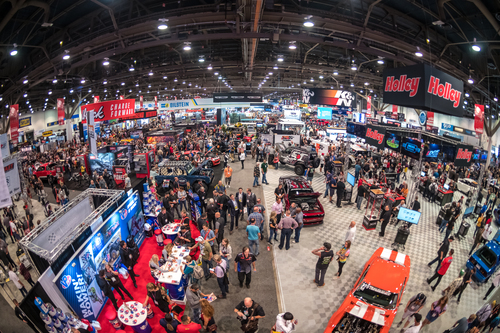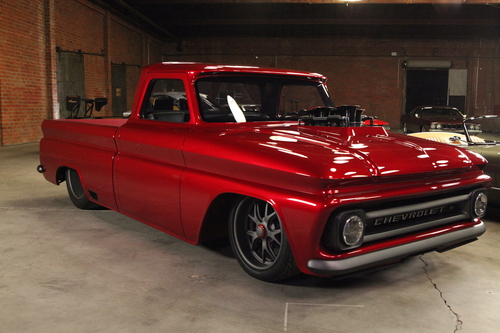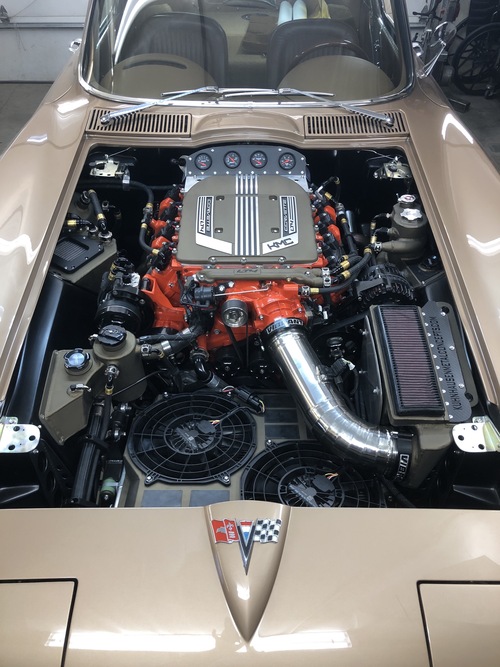BUSINESS
2021 Hot-Rod Market Trends
A Flagship Market Evolves for the Next Generation
By Douglas McColloch

considered ground zero for identifying the latest trends in hot
rodding. In recent years, however, the marketplace has evolved
and expanded. What now constitutes a “hot rod” can no longer
be confined to a single exhibition hall. Still, as a showcase for
many of the industry’s leading legacy brands, it’s a must-see
experience.
The automotive aftermarket has evolved through the years—sometimes gradually, other times suddenly—in response to changes in consumer preferences and advances in technology. Through all the permutations, Hot Rod Alley at the SEMA Show has remained a steady industry focal point—a showcase for the aftermarket’s legacy innovators and their latest parts and projects. First popularized during the postwar years by a handful of shade-tree fabricators, the hot-rod marketplace has grown in the decades since into a global industry comprising thousands of companies that constitute a $1.26-billion market sector, according to the most recent survey from the Hot Rod Industry Alliance.
The vehicle platforms most sought-after by builders have likewise evolved due to recent events that changed the face of hot rodding. In particular, the Goodguys Rod & Custom Association revised its show eligibility criteria in 2018 to include vehicle makes and models up to the ’87 model year. Nowadays, you’ll find ’60s, ’70s and even ’80s musclecars and light-duty pickups standing side by side with ’30s Fords and Chevy Tri-Fives at rod and custom shows around the United States. That development in turn spurred production of new parts for those platforms, and trucks and musclecars are now generally considered to be the hottest-trending players in the hot-rod marketplace.
Like other enthusiast market segments, hot rodding faces a number of challenges in the coming years while also presenting opportunities for future growth. For this article, we contacted some two dozen industry insiders representing manufacturers, fabricators, racers, retailers and media. What follows is a compilation of their insights.

vehicles and pickups such as Mark Giambalvo’s truck-class
winning ’65 C10 from Battle of the Builders 2020 are now
sought-after among builders and highly prized on the rod-and
custom show circuit.
The State of the Industry: Healthy Despite Headwinds
Overall, our panel of experts felt that the marketplace remained robust, but they also acknowledged the business challenges posed over the past 12 months by the COVID-19 pandemic.
“The market in its current state is strong and growing,” said Jeffrey Major, president of BedWood and Parts. “Like most markets, however, it is searching for solutions to the various challenges and opportunities created by COVID-19.”
John McLeod, owner of Classic Instruments, concurred: “I believe we have a strong current state, with some new uncertain situations about the future of events. Many manufacturers and retailers have learned a lot of new ways to conduct business and have found many alternative methods.”
Trevor Hobson, sales manager at CVF Racing, elaborated on that theme.
“Our market is currently very strong,” he said. “While the pandemic we’ve all dealt with over the last 12 months definitely brought about its fair share of challenges, it also brought about some unique opportunities. People working from home suddenly found more time to spend working on their cars rather than commuting in their cars, which in turn brought about orders for new parts.”
David Hays, owner of Hot Rod Innovations, likewise made the connection: “With some of the shows people would normally be attending being cancelled or postponed, people seem more inclined to get out in the garage and work on their rides.”
Andrew Ebel, COO of the Goodguys Rod & Custom Association, remarked on the resiliency of an industry faced with daunting logistical challenges and the need to rapidly adapt to them.
“It’s inspiring to see how so many companies have risen to the occasion to meet and overcome the complex demands that have been placed on them over the past year,” he said. “I believe everyone in our industry has learned some valuable lessons over the past 12 months, which will only make us stronger as we continue to evolve as a community.”

enthusiast market is swapping out older, vintage
technologies and replacing them with newer,
computer-governed operating systems. In this
case, it’s a GM Performance LT4 crate engine
that’s resting between the framerails of Kyle
Kuhnhausen’s ’64 Corvette at Battle of the Builders
2020.
What’s Trending: Classic Trucks and New Tech
Among our group of experts, the overwhelming consensus was that the biggest drivers of market-development growth today are pickups and computer-enabled technologies—most notably, e-commerce and social media.
“We have seen a huge uptick in our truck parts sales,” Hays said. “I’m sure it is no secret that the truck market has really surged over the last few years.”
Major concurred: “The current trend we see continues to be a strong demand for products made for classic haulers and late-model pickups alike. It’s all about trucks, trucks and more trucks.”
Jai Baek, marketing and creative director for United Pacific Parts, saw new OE truck developments such as the Ford Bronco driving growth, as well as the relative availability and affordability of trucks compared to other classic makes and models.
“The new Bronco is helping restoration parts make a big comeback,” he said. “The availability of the C10 makes it easy to convert an old truck to brand-new with aftermarket parts, whereas bodies for Mustangs, Camaros and Model Ts are harder to find.”
Among new developments in the market, the industry-wide shift to trucks and SUVs and the adoption of new technology are probably the most significant, said Tom Scarpello, founder and CEO of Revology Cars. He added that “there is a lot of discussion around electric vehicles (EVs) in our segment, but we have not yet seen any indication of significant consumer interest.”
More specifically, Ebel saw “tremendous signs of growth in the GM G-body and OBS truck genres.
“These genres tend to be more widely available and affordable and are typically favored by a slightly younger and more diverse enthusiast group that as a whole are still in the earlier stages of their hobby—which means that they are super excited and ready to cruise but may not be ready to take on a restoration or build,” he said.
New technology for old iron still remains a strong seller as well.
“People want to replace old parts with the newest technology, from LED lights to the newest steel bodies,” Baek said, and Hobson noted the continued popularity of his company’s LS-engine drive systems.
New Media: Essential Lockdown Marketing Tools
While shelter-in-place orders and remote working opportunities gave many enthusiasts additional time to work on their projects, those developments also pointed out the need for aftermarket companies to stay in touch with their most loyal customers via the internet.
“The continued expansion of digital marketing is allowing new companies and brands to gain disproportionate awareness relative to their spending levels, ultimately leading to greater specialization and fragmentation within the industry,” Scarpello said.
Ebel noted that e-commerce and learning how to harness the power of online consumers have been hugely important for years, but it was what set some companies apart from their competitors in 2020 and what will continue to be a cornerstone of growth for the industry moving forward.
“While it can be costly for companies to effectively navigate the world of e-commerce and digital marketing, it’s an absolute must in today’s marketplace,” he said. “The companies that embrace and implement the technology best will be at the head of the pack in the coming years.”
Baek concurred, observing that “the rapid growth of social media and the ability to search products online changed the landscape of business. Prior to COVID-19, we knew that social media could play a larger part in the hot-rod industry, so we were always making marketing content for our parts and e-commerce on a regular basis, but when COVID-19 hit, it was like a tsunami. Everyone was watching video and content on an iPhone. We were racing to create content for social media and writing data for e-commerce at a much faster pace.”
Baek said that anyone with resources and money can manufacture products, but unique content marketing will stand out from the crowd.
“Branding goes beyond just the logo, print or graphic,” he said. “You need to create a story that makes a memorable impression on consumers and, at the same time, allows your customers and clients to know what to expect from your company.”
To succeed in the digital marketplace, Baek advised companies to embrace
technology.
“Hot-rod customers and enthusiasts want your product information available 24/7,” he said. “Technology platforms like social media and Google search give an opportunity to engage with your customers. Having stunning classic content or how-to videos offers an opportunity to grow your brand.”

for speed shops and manufacturers going forward is fully
leveraging the power of digital media—and social media in
particular—to maintain ongoing relationships with their
customer bases and to craft compelling online narratives that
will make a company’s products and services indispensable in
the eyes of consumers. Photo courtesy: Shutterstock
Challenges and Opportunities
Nearly all of our experts agreed that the biggest challenge facing the industry in the short term has been the convulsive influence of COVID-19 upon the existing business model and the need to adapt to changes in consumer shopping habits and unforeseen market conditions.
“Obviously and overwhelmingly, COVID-19 has been our biggest challenge and hurdle over the past year,” Ebel said. “While it severely impacted our revenues and partnerships, it also forced us to introduce new and innovative revenue platforms and challenged us to implement new technologies that will improve our overall value to our partners.”
“The most promising opportunities for growth are going to be for gaining back efficiencies lost due to the pandemic,” Hobson said, “whether that is figuring out a new way to do things or some adaptation of the way that things used to be done.”
Another issue related to the pandemic that was mentioned by more than one of our sources was the challenge of global supply-chain disruptions.
“The biggest challenges are going to be related to the supply chain and employees,” Hobson said. “Some items are still in short supply, which drives up costs and makes expanding quite difficult. Parcel companies are also feeling the strain, and we’ve all been hit with higher costs and additional lead times, which isn’t conducive to growth.”
McLeod agreed that supply problems and raw goods are the challenge for most all companies.
“Certain areas have been hit harder than others, and if your goods come from those areas, the trickle down starts,” he said. “Again, we are finding new ways to do business, though I personally believe that face-to-face business and shaking a person’s hand is still the best way.”
A more longstanding challenge facing the hot-rod market has been the difficulty in devising an effective outreach strategy to attract a new generation of builders and enthusiasts.
“It’s hard to find a new demographic of hot-rod enthusiasts,” Baek explained. “We know that there are younger generations out there who are showing interest, but they seem to have less interest in the process. That doesn’t mean they don’t have an appreciation for vintage cars. They love attending shows with friends and family, but they don’t want to spend countless hours polishing and building cars.”
Still, as COVID-19 vaccinations continue to roll out during the spring and the economy continues to gain steam, our experts’ outlook on the future was uniformly bright.
“It is all positive,” McLeod said. “We will see shows starting to open, events starting to run again. Our industry will recover and do fine. I truly believe that we will see a bunch of new customers and rekindled passions.”
Hays elaborated: “I look for the sport to have a huge uptick in activity. Sometimes it takes having what feels like something being taken away for us to fully appreciate it.”
“We are bullish on the outlook for FY21, assuming the supply chain is able to fully recover early in the year,” Scarpello said. “If so, it will be another record year for us.”
Ebel summed it up: “If we keep our feet on the gas, there are going to be lots of good times ahead.”
 Hot-Rod Industry Resources
Hot-Rod Industry Resources
Hot Rod Industry Alliance: The SEMA Hot Rod Industry Alliance works to ensure the future prosperity of the hot-rod industry and to advance and promote awareness of the hobby. To learn more about how your business can become involved and benefit from the community, visit www.sema.org/hria.
 SEMA Action Network: The SEMA Action Network (SAN) is a nationwide partnership between vehicle clubs, enthusiasts and members of the specialty auto parts industry who want to protect their hobby. Founded in 1997, the SAN was designed to help stamp out legislative threats to the automotive hobby and pass favorable laws. To learn more and join, visit www.semasan.com.
SEMA Action Network: The SEMA Action Network (SAN) is a nationwide partnership between vehicle clubs, enthusiasts and members of the specialty auto parts industry who want to protect their hobby. Founded in 1997, the SAN was designed to help stamp out legislative threats to the automotive hobby and pass favorable laws. To learn more and join, visit www.semasan.com.






